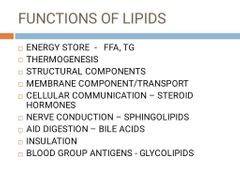![]()
![]()
![]()
Use LEFT and RIGHT arrow keys to navigate between flashcards;
Use UP and DOWN arrow keys to flip the card;
H to show hint;
A reads text to speech;
27 Cards in this Set
- Front
- Back
- 3rd side (hint)
|
General on Lipids |
• Very abundant in nature • A major component of our diet (together with Proteins and Carbohydrates) • Exists in a wide variety (phospholipid, triglycerides, waxes, terpenes, etc) • Soluble/miscible in ORGANIC compounds (like ethanol, benzene) • Insoluble in water. |
|
|
|
Is alcohol an organic compound |
Yes it is, it is produced by us during anaerobic respiration |
|
|
|
Classification of lipids |
● Fatty acids (trans, saturated, unsaturated) ● Cholesterol (Steroid) ● Acylglycerol/glyceride (mono, di and triglyceride) ● Sphingolipids (Sphingosine based) ● Terpenes (Vit A, K, E) ● Phospholipids ● Bile acids ● Glycolipids
|
|
|
|
Define lipids |
Lipids are compounds that are insoluble in water but soluble/miscible in organic solvents |
|
|
|
Examples of monounsaturated, polyunsaturated and saturated fatty acids |
Mnemonics: MOP & PEAL Some PALMS ● MOP (Monounsaturated = Oleic and Palmitoleic acid) ● PEAL (Polyunsaturated = Eicosapentaenoic, Arachidonic, Linoleic, Linolenic) ● Some PALMS (Saturated = Palmitic, Myristic, Stearic) |
|
|
|
Mention the functions of Lipids |

|
|
|
|
The most abundant lipid in diet is? What percentage of total dietary lipid is it? |
Triglycerides (90% of total dietary lipids) |
|
|
|
Lipase converts triglycerides to |
Fatty acid and glycerol (according to clin path) |
|
|
|
Lipoprotein are made of |
Proteins(Apolipoproteins) and Lipids. |
|
|
|
Functions of apolipoproteins |
1) They help to transport lipids 2) They activate and inhibit action of lipase 3) They regulate metabolism of lipoprotein 4) They are important structural molecules |
|
|
|
The core of a lipoprotein is composed of |
Triglycerides and cholesterol esters (water insoluble molecules) |
|
|
|
The surface of the lipoprotein is composed of |
Apolipoprotein, Phospholipids, Cholesterol (Amphipathic and water soluble molecule) |
|
|
|
Mention the different types of lipoproteins |
● Chylomicrons ● VLDL ● IDL ● LDL ● HDL ● Lipoprotein a (special kind of LDL) |
|
|
|
Lipid metabolism is divided into |
● Exogenous metabolism ● Endogenous metabolism ● Intracellular cholesterol metabolism ● HDL reverse cholesterol transport |
|
|
|
Lipid disorders are classified based on |
● Fredrickson's/WHO classification (for lipoproteins) ● Predominant lipid (Triglyceride or Cholesterol) ● Etiology of Hyperlipidaemia |
|
|
|
Alpha lipoprotein is |
HDL |
|
|
|
Beta lipoprotein is |
LDL |
|
|
|
Pre beta lipoprotein is |
VLDL (IDL is broad beta lipoprotein) |
|
|
|
Fredrickson's classification (lipoprotein) of disorder include |
● Type 1 - Increased chylomicrons ● Type 2a - Increased LDL (Beta lipoprotein) ● Type 2b - Increased LDL (Beta lipoprotein) and VLDL (pre-Beta lipoprotein) ● Type 3 - Increased IDL (broad Beta lipoprotein) ● Type 4 - Increased VLDL ● Type 5 - Increased VLDL and chylomicron |
It uses electrophoresis arrangement of lipoproteins and it doesn't consider HDL |
|
|
Classification based on Predominant lipid in plasma |
● Predominant Hypercholesteraemia ● Mixed Hyperlipidaemia (both cholesterol and triglycerides) ● Predominant Hypertriglyceridemia |
|
|
|
Arrangement of lipoproteins based on density and electrophoresis |
Density : HDL>LDL>IDL>VLDL>Chylomicrons Electrophoresis (anode to cathode) : HDL>VLDL>IDL>LDL>Chylomicrons |
|
|
|
Based on etiology, lipid disorders are classified into |
● Primary Hyperlipidaemia ● Secondary Hyperlipidaemia ● Primary Hypolipidemia ● Secondary Hypolipidemia Primary is due to genetic malformation, Secondary is acquired |
|
|
|
Primary hyperlipidaemia conditions include |
● Chylomicron syndrome ● Familial Hypercholesteraemia ● Familial Hypertriglyceridemia ● Familial combined hyperlipidaemia ● Familial defective Apo B- 100 ● Type 3 hyperlipidaemia ● Polygenic Hypercholesteraemia ● Hyperalphalipoproteinemia |
|
|
|
Primary Hypolipidemia conditions include |
● Tangier's disease ● Abetalipoproteinemia |
|
|
|
Features of Chylomicron syndrome include |
● Abdominal pain (with acute pancreatitis) ● Eruptive xanthoma (swellings on the skin) ● Hepatosplenomegaly ● Lipaemia retinalis (deposits in the eyes) |
|
|
|
The gene that codes for formation of Lipoprotein lipase is on what chromosome |
Chromosome 8 |
|
|
|
Difference between Familial and Polygenic Hypercholesteraemia |
●Familial is purely due to genetic mutation and is autosomal dominant ●Polygenic is due to genetic and environmental factors ●Familial presents with severe hypercholesteraemia ●Polygenic presents with mild/moderate hypercholesteraemia ●Familial presents with xanthoma in hands, Achilles tendon ●Polygenic doesn't present with xanthoma at all |
|

